Investing in Crypto: What Investing Options Do You Have?
In this section, we're going to talk about all the different ways of how to invest in crypto!
Investing in crypto is a wide topic. It's constantly evolving, as new opportunities, strategies, and risks appear every now and then. There are different sections in this Crypto 101 Handbook which concentrate on particular methods of crypto investment, such as staking or mining. In this section, though, I’ll touch on them all, so you could have the full picture of this fascinating topic.
The question of how to invest in crypto is an interesting one, since there are many answers. It's enough to take a glimpse into the online crypto space, and you'll instantly notice how polarizing this debate can be! So, before forming your own opinion, you gotta get to know what these different ways are. It can get complex and confusing, but fear no more – that's what I'm here for!
In this section, we're going to discuss different ways of how to invest in cryptocurrencies. These include buying, mining, staking, the perks of Decentralized Finance (DeFi), Non-Fungible Tokens (NFTs), and finally, investing in GameFi. I'll describe each of them as we'll look into what makes them so different, on their own. Eventually, you'll see that, no matter your level of experience, crypto investing for beginners is also a thing!
Now, let's get to it!

Video Explainer
Video Explainer: Investing in Crypto: What Investing Options Do You Have?
Reading is not your thing? Watch the "Investing in Crypto: What Investing Options Do You Have?" video explainer
How to Invest in Crypto: 6 Rewarding Strategies (Animated)


Options of Investing in Crypto
Investing in crypto is like a Swiss army knife. It can have many shapes and forms, but it all boils down to expectations of generating a return on investment. The most popular form of it - purchasing digital coins - is only the tip of the iceberg, since there are many more ways to achieve this goal.
But let's begin with the classics - first on the list is simply buying and hodling crypto.
Buying Cryptocurrency & HODLing
In technical terms, buying crypto refers to acquiring a specific digital coin (or token) by buying it for traditional fiat currency, be it dollars, euros, or something else, or exchanging other cryptocurrencies for it.
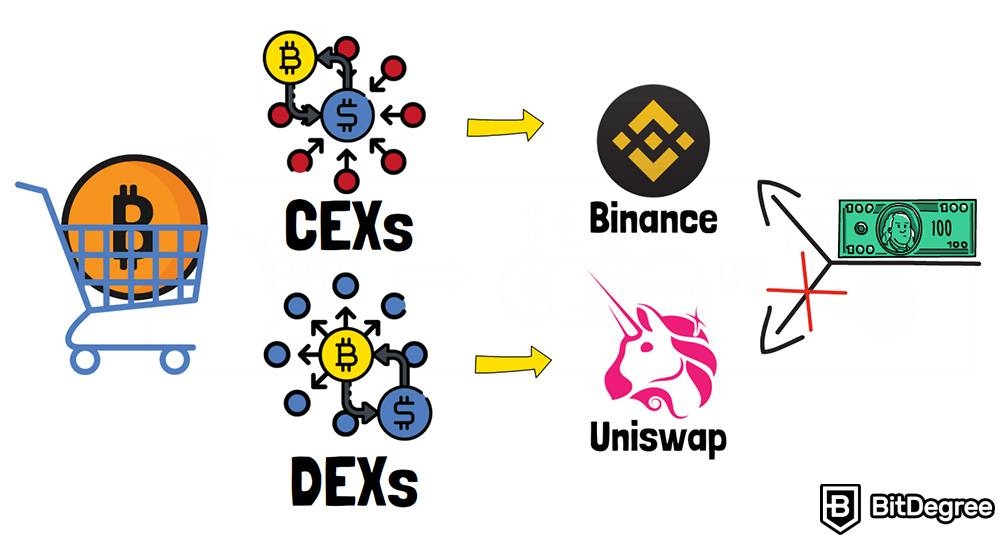
You can buy cryptocurrency on a CEX, a centralized exchange, like Binance, or a DEX, a decentralized exchange, like Uniswap. Keep in mind that, unlike centralized exchanges, you can't buy crypto for fiat money on decentralized platforms. But that's a different topic, so if you want to learn more, be sure to check out this section.
So, essentially, investing in cryptocurrency by acquiring crypto is self-explanatory. You literally invest in a coin with the hopes that its price will increase over time, which will allow you to sell it and end up pocketing some profit. This is very similar to investing in companies in their early stages by buying their stocks and being able to sell them once the company makes it big.
Or, to make it more simple, it's like obtaining an object just after it comes out and selling it later, when it becomes a rarity. A perfect example would be the first edition of Harry Potter. In 2021, a copy of the first edition of Philosopher's Stone sold for $471,000. Its value increased over time, and the owner was able to make a profit by selling it. The same applies to everyone who bought their Bitcoin for mere cents 10 years ago, and held on to it. Today, they are millionaires.
But they wouldn't be if they didn't follow that one, essential principle of smart crypto investing. It's known as "HODL." The expression was accidentally created in 2013, in a Bitcoin forum, where an enthusiastic crypto trader made a typo while trying to spell out HOLD. The funny mistake became part of the community's lingo, and today is known as the acronym for "Hold On for Dear Life."
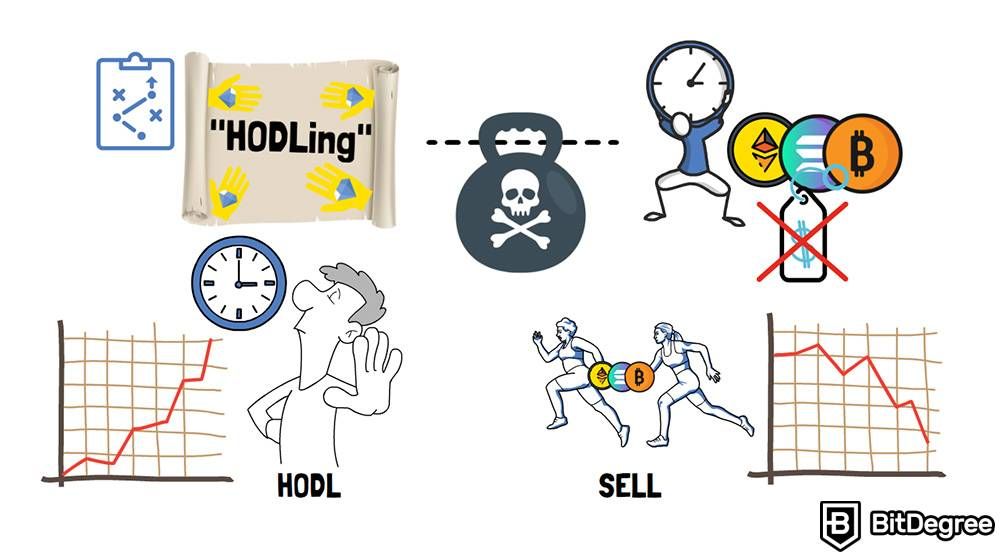
HODLing has become a term used to describe the strategy of holding onto a particular cryptocurrency for a long period of time, rather than selling it. HODLing gets difficult when the price of a coin falls drastically. Most people run to sell it, while HODLers refuse to do so, hoping that, in the long term, the price will recover, and increase.
Sometimes it’s irrational, sometimes, it doesn’t work out. It’s a bet, after all. But sometimes it works - just like someone was HODLing on that first edition of the Harry Potter book until its value skyrocketed, so do crypto investors HODL on particular coins, hoping to make a profit one day.
Mining
Moving on, let's take a look at mining, as a method of how to invest in cryptocurrencies.
Mining is the process of validating transactions on a blockchain, and earning rewards in the form of cryptocurrency for doing so. Mining requires specialized computer hardware for its computational power, and naturally, it uses a lot of energy. The nitty-gritty of the technical side of it would require an entire section to cover.

In its very essence, though, mining is a costly way of investing in crypto. Even though blockchains and their verification mechanisms differ, becoming a crypto miner is not something most people could afford. Therefore, various solutions were introduced, such as cloud mining.
Cloud mining is hiring a mining company to do the mining for you. You pay the company for their service, but in exchange, you give them an agreed-upon amount of the mined resources. Instead of buying and maintaining your own equipment, you simply rent hash power from a mining farm, and they do the job for you.
It's important to note that this only applies to coins that are native to blockchains that run on the Proof-of-Work consensus mechanism. There are others, such as Ethereum's Proof-of-Stake, and this brings us to another way of investing in crypto – staking.
Staking
For crypto freshmen, staking immediately gives off confusion, but for more advanced investors, it is something they don't ignore.
Staking is rather similar to depositing money into banks. Sometimes, banks promise interest rates for those who are willing to deposit large amounts of money into them. It’s similar when it comes to staking. But it has a different purpose.
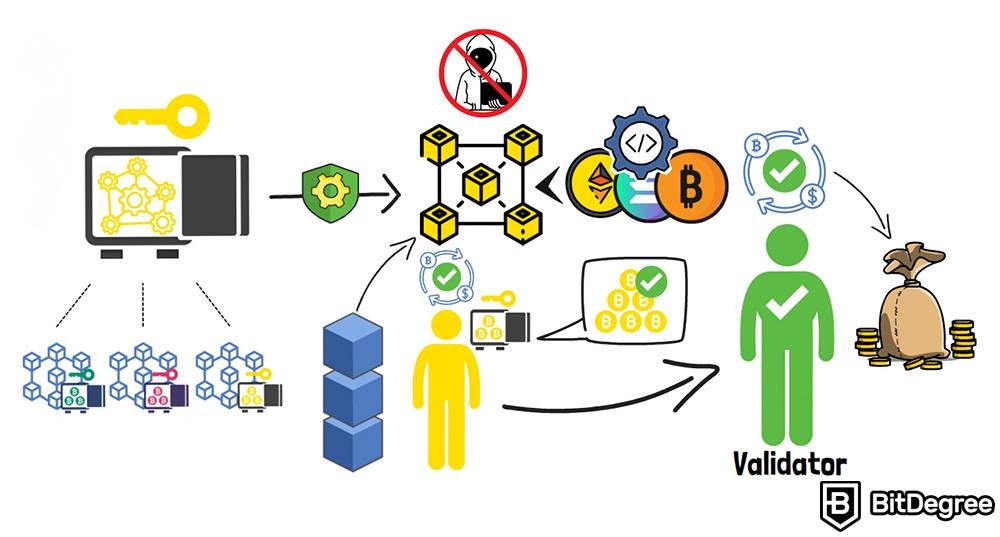
In the context of crypto, staking refers to locking up a certain amount of coins inside a blockchain, so that it could be used as collateral to support the operations of the network. It's a rather complex mechanism, and it differs from blockchain to blockchain. Nevertheless, its purpose is to help secure the network.
This is achieved by the fact that stakers are the ones who receive the rights to validate transactions and compete to add new blocks to the blockchain. After having staked a required amount, stakers become the validators.
For validating transactions, they receive rewards. Staking also works as a deterrent for malicious behavior. If a validator decided to engage in some shady business, they would be punished, as their staked assets would be confiscated.
So, if you're doing good, you get rewards. Just don't get any funny ideas.
Decentralized Finance (DeFi)
The next stop on the ‘how to invest in crypto’ train is Decentralized Finance, or DeFi. It sounds so broad, that it looks like you could cover all ways of investing in crypto under this blanket-term. Yet, DeFi in itself is an emerging ecosystem of financial applications that provide new, less conventional ways of getting into crypto.
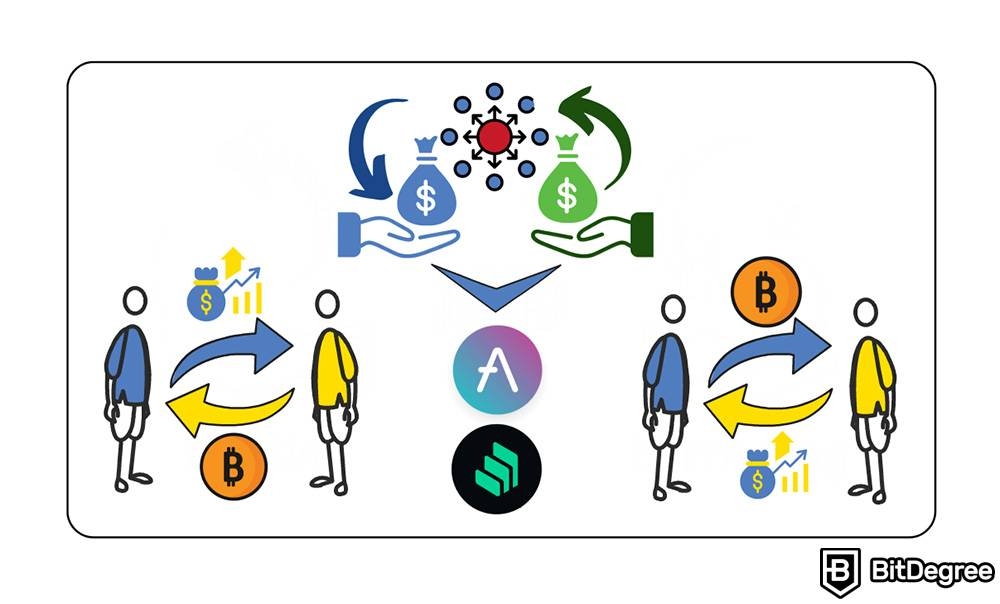
Among smart crypto investing opportunities, I shall emphasize lending and borrowing first. It's literally what it sounds like - DeFi lending and borrowing allow investors to lend crypto to others and earn interest, or - the opposite - borrow crypto and pay interest. Platforms like Aave, Compound, and many others are offering these services.
Another way of investing in crypto within the DeFi world is known as providing liquidity. It's thanks to liquidity providers that DEXs are a thing. When you're trading, swapping, or buying crypto on decentralized exchanges, the assets you're after don't just fall from the sky. They come from liquidity pools that exist thanks to those who decided to put their coins into them.
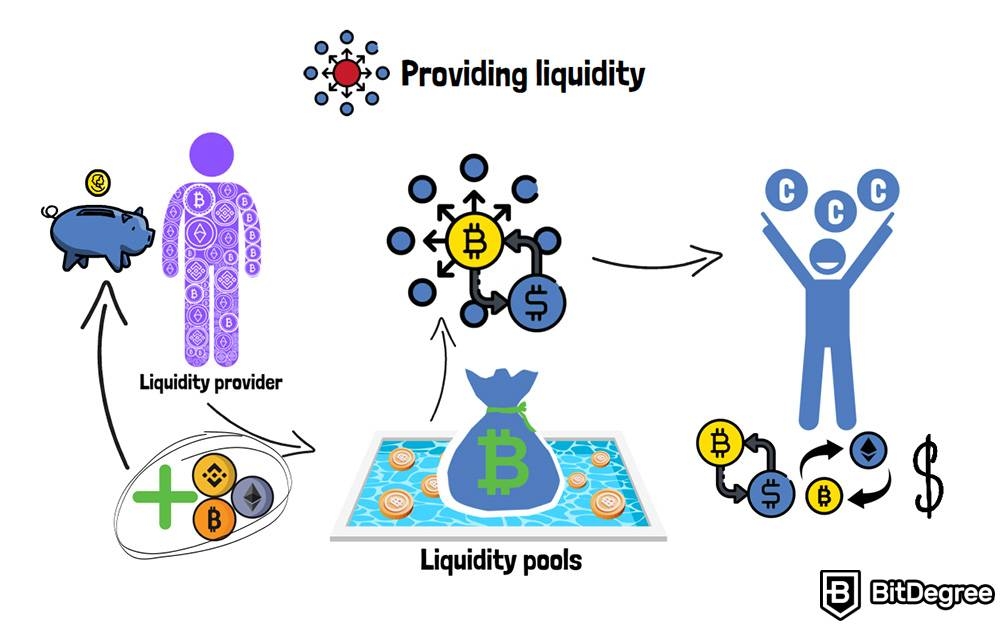
The richer the liquidity pools, the higher the volume of trades that can be executed, and by doing so, investors earn a fee from each trade that happens, thanks to the liquidity they provide.
But liquidity could be provided not only to liquidity pools. Another method that includes gaining passive income from a similar tactic is called yield farming. It's similar to liquidity providing. Investors deposit their money into a DeFi protocol's liquidity pool, and earn money from all the trades that were possible thanks to this pool.
But here, investors can also gain financial rewards in the form of newly issued tokens that are distributed to liquidity providers as a reward for their contribution.
Non-Fungible Tokens (NFTs)
The next method of how to invest in crypto are the famous NFTs, or Non-Fungible Tokens. NFTs are a type of digital asset that represents ownership of a unique item or piece of content, such as art, music, or any collectibles, in general. Even real estate or unique passes to events and community gatherings can also come in the form of NFTs. They can be bought, sold, and traded on various NFT marketplaces such as OpenSea, Blur, Magic Eden, and others.
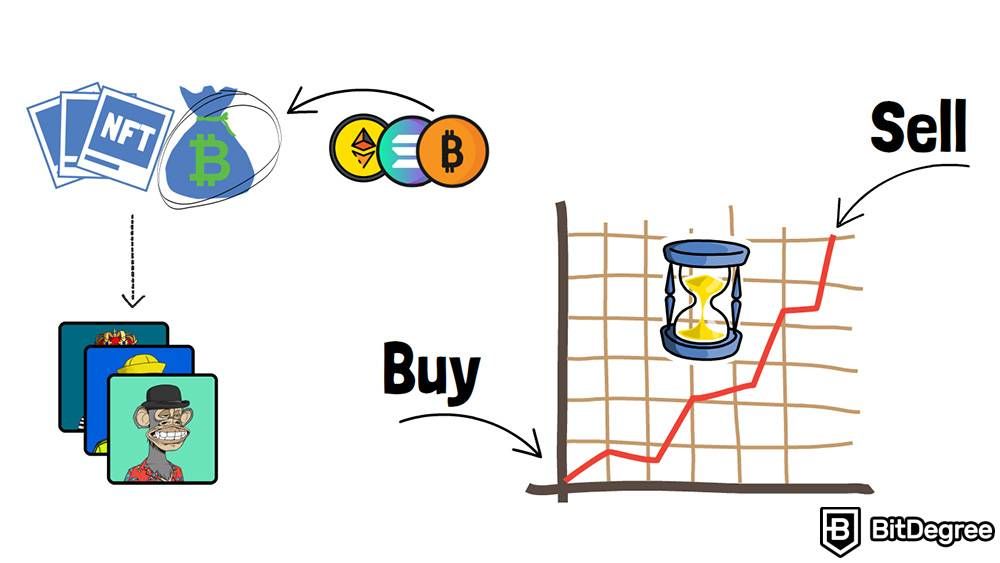
NFTs offer a new way to invest in digital art and other unique digital assets, and the investment part here looks very similar to investing in crypto coins. You try to buy low, and then wait for an opportunity to sell high.
There's a term for short-term profit strategies when it comes to NFTs, and it's called flipping. Flipping refers to buying an NFT and then immediately selling it for a higher price. This can be a quick way to make a profit, but it's also a high-risk strategy, as the value of an NFT can be highly volatile.
The opposite of flipping is hodling. I’ve already explained how hodling works earlier in this section. When it comes to NFTs, hodling means the same thing. Note that if you want to understand NFTs in-depth, there is a separate section about them - check it out!
GameFi
And, finally, finishing off our list of the best crypto investing strategies, we've got one of the latest trends - GameFi. In a few words, it allows you to earn cryptocurrency by gaming. One of the most famous examples is Axie Infinity. However, GameFi goes deeper than that.
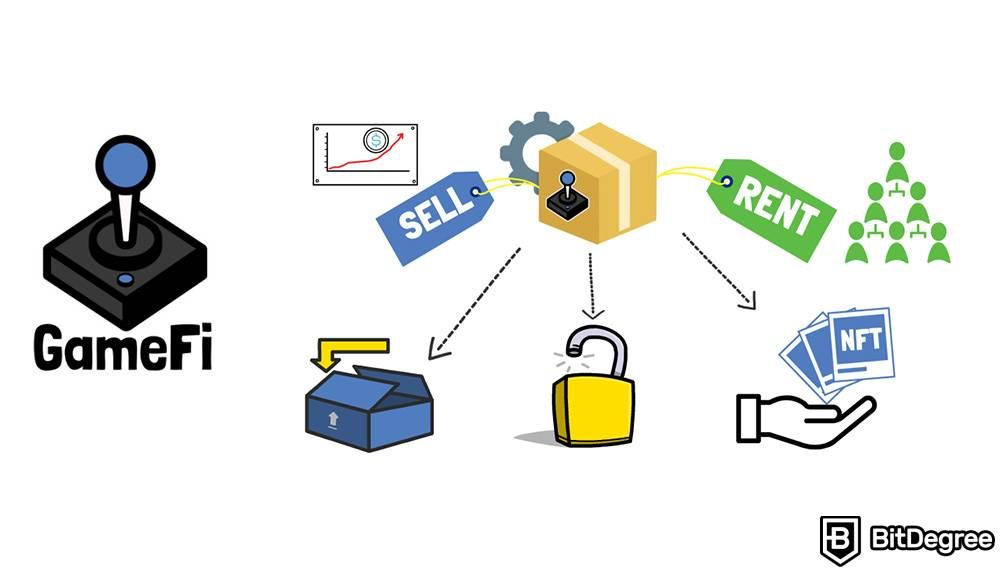
If you really believe in a particular game, you can obtain, unlock, or buy NFTs of in-game items, which you can either sell later for a bigger price, or even rent out to someone else. Just like NFTs, but in-game.
GameFi is still in its early stage. This industry could be the very next thing, or it could take a while until the gaming culture adapts to what Web3 can bring them. Therefore, it's safe to say that, when it comes to investing in GameFi, the risk is pretty high, and the future is yet to be clear.
Wrapping Up
As you can see, when it comes to different verified crypto investing strategies, you find yourself with a rather wide variety of choices, yet with no clear, single answer to how to invest in crypto. Yes, it's confusing at first, but that's not a bad thing. No matter what type of investor you might be, crypto offers many different possibilities that are likely to suit everyone's taste, skills, and character.
Lastly, note that the aforementioned ways of investing in crypto differ in their technical complexity, the required level of knowledge, or simply, the amount of funds necessary in order to be able to participate in them.










